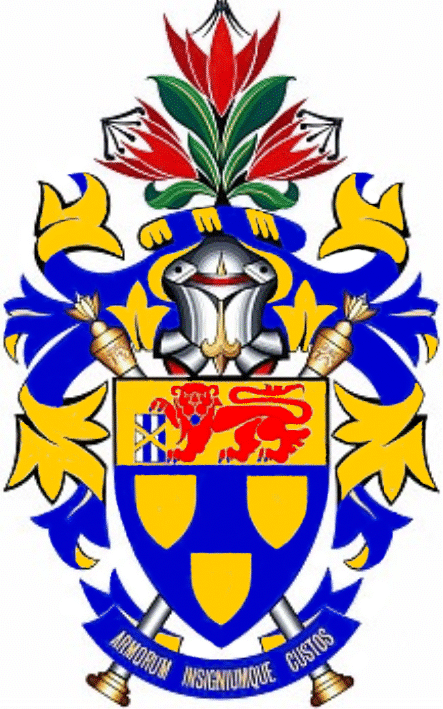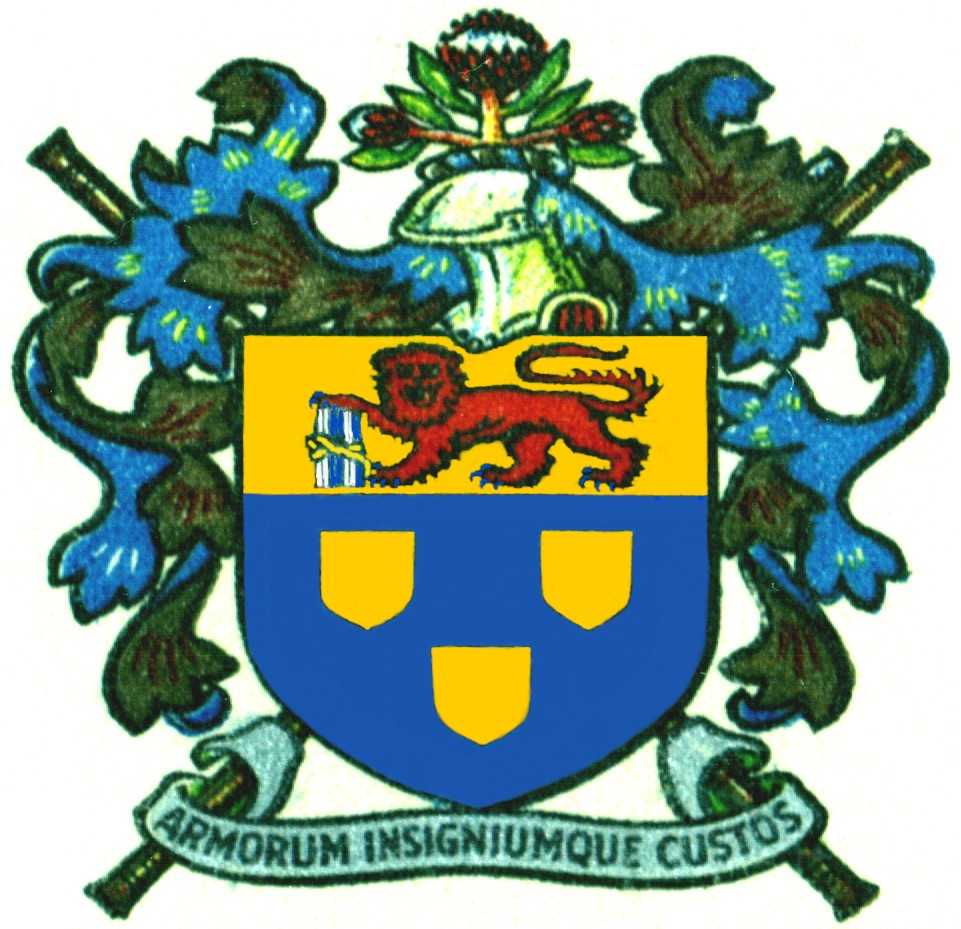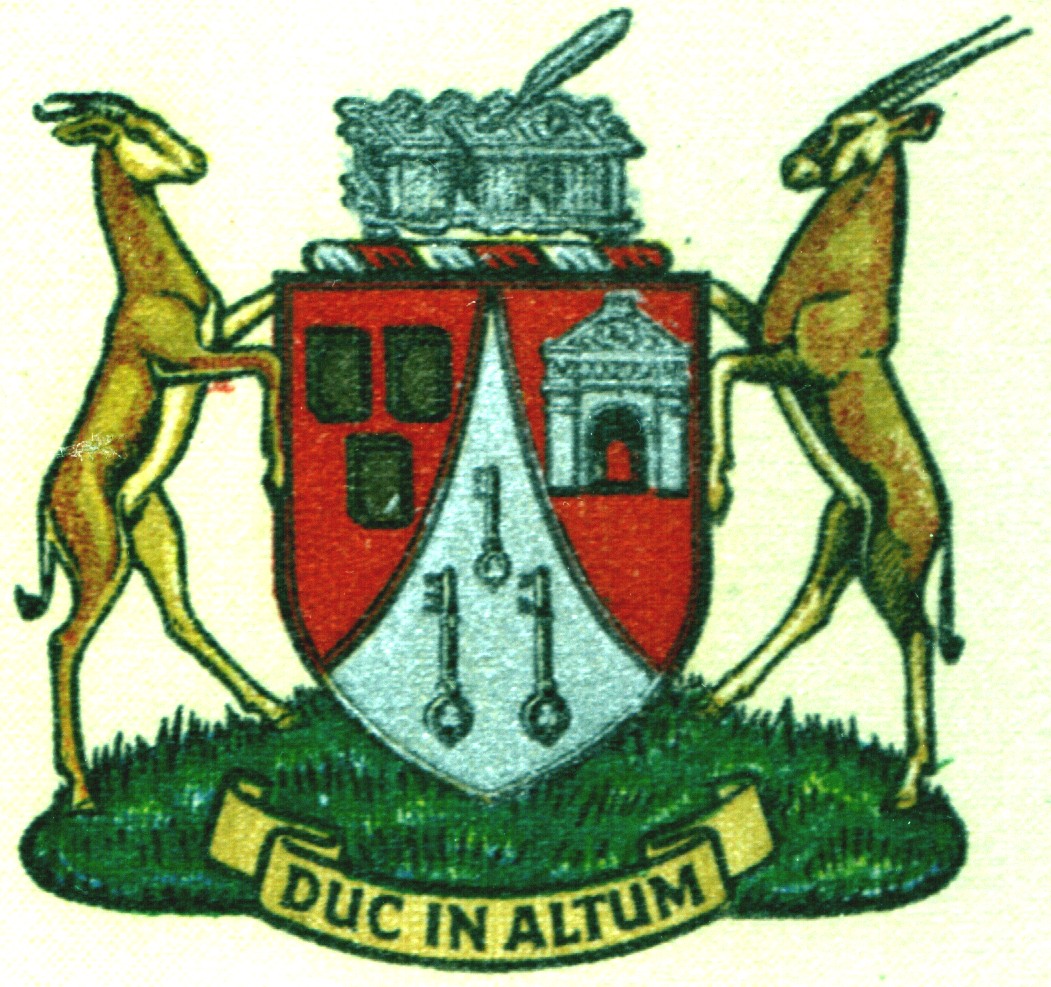

Bureau of Heraldry, Pretoria

The arms of the Bureau are blazoned:
Arms: Azure, three escutcheons Or, placed two and one, and on a
chief Or the South African lion (to wit, the lion as presented in the crest of
the coat of arms of the Republic of South Africa).
Crest:
On a wreath Or and Azure, a branch of Protea containing three flower-heads and
leaves, all proper. Mantling: Or and Azure.
Batons:
The representation as a whole superimposed on two batons placed in saltire, Or.
Motto: ARMORUM INSIGNIUMQUE CUSTOS.

The arms were approved by the President’s[1] office, and were proclaimed under Government Notice 409, published in Government Gazette No 1 067 of 26 March 1965.
The Bureau subsequently issued a certificate of registration (No H2/9) on 1 March 1966, which is in English.
About the arms:
The three gold escutcheons clearly symbolise the Bureau’s function of creating and registering coats of arms.
The lion in the
chief is taken from the crest of the Republic of South
Africa (as used from 1961 to 2000), symbolising the authority of the State
under which this is done.
The lion holds
four staves, two silver (white) and
two blue, bound together with a golden cord.
The flowers in
the crest are simply named as Protea, which means they could belong to any of a number of species of this genus. They quite definitely are not Protea cynaroides, the national flower. They closely resemble Protea eximia, a species found widely in the fynbos[2] region between Worcester and Port Elizabeth, and have
some resemblance to Protea magnifica (formerly Protea barbigera), the natural range of which is in the western mountains from Pakhuis Pass in the Cedarberg to Houw Hoek in the Boland mountains.
They also bear a
fleeting likeness to Protea caffra,[3] also called the tickey protea.[4]
In the older
version of these arms (shown at right), which in the Bureau’s earlier days
appeared on all certificates of registration, the proteas were drawn much more
like Protea cynaroides.
![National Herald Themba Mabaso (right) and his deputy, Marcel van Rossum, parading in heraldic garb in St Andrews [Picture courtesy of Appleton Studios]](SA_heralds.jpg)
The diagonally crossed batons in front of which the arms are placed symbolise the office of herald.
The motto translates as “Custodian of arms
and insignia” – which, in short, is the Bureau’s function.
About the Bureau:
The Bureau of Heraldry came into existence
in on 1 June 1963, the principal consequence of the passage of the Heraldry Act of
1962.
Dr Coenraad
Beyers was appointed State Herald in a caretaker capacity when the Bureau was
established.[5]
He was succeeded by Norden Frederick Hartman, who was State Herald from 1 December 1964 until 30 April 1982. It was during his term of office that the Heraldry Act was amended in 1969.
Frederick Gordon
Brownell, having served as Assistant State Herald from 1 August 1977, was appointed State Herald on 1 May 1982. He continued in office beyond the normal retirement age, finally retiring on 31 January 2002, having completed 19 years and nine months in office.
His successor, Themba Mabaso, was appointed as National Herald (and the position was upgraded to a directorate) on 1 February 2002. He is still in office.
In August 2006 Mr Mabaso and his deputy, Marcel van Rossum, attended the XXVII Congress of Genealogical and Heraldic Sciences in the university town of St Andrews, Scotland. A feature of the congress was a parade through the town of heralds in full regalia, and Mr Mabaso and Mr Van Rossum were to be seen in what were termed tabards.[6]
The Bureau forms part of the National Archives, and the early registration certificates issued under the Heraldry Act always showed the arms of both the Bureau and the Archives (shown here at right).

Contacting the Bureau:
People wishing to make inquiries of the Bureau, register their arms or other insignia, or inspect its record of arms registered, may write to Private Bag X236, Pretoria 0001, or telephone the office at 012-323 5300 (when dialling from outside South Africa, +27-12-323 5300) – this number is for the Archives switchboard.
There are two fax numbers: 012-323 5287 (+27-12-323 5287) and for fax to e-mail, 086 682 5055 (+27-86 682 5055).
The Bureau does not currently have a website of its own, but it occupies part of the Archives website here. For e-mail contact write to [email protected]
The blazons of registered coats of arms and other devices can also be located online. Search in the National Automated Archival Information Retrieval System, or NAAIRS.
The tariff charged by the Bureau for registering arms and other devices is given here.
